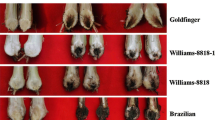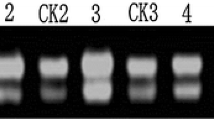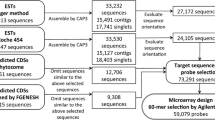Abstract
Pathogenic diseases represent a major constraint to the growth and yield of cacao (Theobroma cacao L.). Ongoing research on model plant systems has revealed that defense responses are activated via signaling pathways mediated by endogenous signaling molecules such as salicylic acid, jasmonic acid and ethylene. Activation of plant defenses is associated with changes in the expression of large numbers of genes. To gain a better understanding of defense responses in cacao, we have employed suppressive subtractive hybridization (SSH) cDNA libraries, macroarray hybridization analysis, high throughput DNA sequencing and bioinformatics to identify cacao genes induced by these signaling molecules. Additionally, we investigated gene activation by a phytotoxic elicitor-like protein, Nep1. We have identified a unigene set of 1,256 members, including 330 members representing genes induced during the defense response.

Similar content being viewed by others
References
Altschul SF, Gish W, Miller W, Meyers EW, Lipman DJ (1990) Basic local alignment search tool. J Mol Biol 215:403–410
Bailey BA (1995) Purification of a protein from culture filtrates of Fusarium oxysporum that induces ethylene and necrosis in leaves of Erythroxylum coca. Phytopathology 85:1250–1255
Beers EP, Woffenden BJ, Zhao C (2000) Plant proteolytic enzymes: possible roles during programmed cell death. Plant Mol Biol 44:399–415
Bennett AB (2003) Out of the Amazon: Theobroma cacao enters the genomic era. Trends Plant Sci 8:561–563
Bolwell GP, Bindschedler LV, Blee KA, Butt VS, Davies DR, Gardner SL, Gerrish C, Minibayeva F (2002) Apoplastic oxidative burst in response to biotic stress in plants: a three-component system. J Exp Bot 53:1367–1376
Chandok MR, Ytterberg AJ, van Wijk KJ, Klessig DF (2003) The pathogen-inducible nitric oxide synthase (iNOS) in plants is a variant of the P protein of the glycine decarboxylase complex. Cell 113:469–482
Chang S, Puryear J, Cairney J (1993) A simple and efficient method for isolating RNA from pine trees. Plant Mol Biol Rep 11:113–116
Cramer RA, Lawrence CB (2004) Identification of Alternaria brassicicola genes expressed in planta during pathogenesis of Arabidopsis thaliana. Fungal Genet Biol 41:115–128
Delledonne M, Zeier J, Marocco A, Lamb C (2001) Signal interactions between nitric oxide and reactive oxygen intermediates in the plant hypersensitive disease resistance response. Proc Natl Acad Sci USA 98:13454–13459
Devoto A, Muskett PR, Shirasu K (2003) Role of ubiquitination in the regulation of plant defense against pathogens. Curr Opin Plant Biol 6:307–311
Diatchenko L, Lau YFC, Campbell AP, Chenchik A, Moqadam F, Huang B, Lukyanov S, Lukyanov K, Gurskaya N, Sverdlov ED, Siebert PD (1996) Supression subtractive hybridization: a method for generating differentially regulated or tissue-specific cDNA probes and libraries. Proc Natl Acad Sci USA 93:6025–6030
Dixon RA (2001) Natural products and plant disease resistance. Nature 411:843–847
Dodo, HW, Fritz PJ, Furtek DB (1992) A cocoa 21 kilodalton seed protein has trypsin inhibitory activity. Café Cacao 36:279–284
Gorlach J, Volrath S, Knauf-Beiter G, Hengy G, Beckhove U, Kogel KH, Oostendorp M, Staub T, Ward E, Kessmann H, Ryals J (1999) Benzothiadiazole, a novel class of inducers of systemic acquired resistance, activates gene expression and disease resistance in wheat. Plant Cell 8:629–643
Green, MT, Maller NC, Richmond SA, Morris D, Ball PR, Stephens SK (2002) Robust and sensitive nylon hybridization membrane suitable for high-throughput robotic arraying applications. Biotechniques 33:430–434
He ZH, He D, Kohorn BD (1998) Requirement for the induced expression of a cell wall associated receptor kinase for survival during the pathogen response. Plant J 14:55–63
Jones PG, Allaway D, Gilmour DM, Harris C, Rankin D, Retzel ER, Jones CA (2002) Gene discovery and microarray analysis of cacao (Theobroma cacao L.) varieties. Planta 216:255–264
Keates SE, Kostman TA, Anderson JD, Bailey BA (2003) Altered gene expression in three plant species in response to treatment with Nep1, a fungal protein that causes necrosis. Plant Physiol 132:1610–1622
Lorenzo O, Piqueras R, Sanchez-Serrano JJ, Solano R (2003) ETHYLENE RESPONSE FACTOR1 integrates signals from ethylene and jasmonate pathways in plant defense. Plant Cell 15:165–178
McKenzie DJ, McLean MA, Mukerji S, Green M (1997) Improved RNA extraction from woody plants for the detection of viral pathogens by reverse transcription-polymerase chain reaction. Plant Dis 81:222–226
Neuhaus JM (1999) Plant chitinases. In: Datta SK, Muthukrishnan S (eds) Pathogenesis-related proteins in plants. CRC, New York
Pieterse CM, van Wees SC, van Pelt JA, Knoester M, Laan R, Gerrits H, Weisbeek PJ, van Loon LC (1998) A novel signaling pathway controlling induced systemic resistance in Arabidopsis. Plant Cell 10:1571–1580
Queitsch C, Sangster TA, Lindquist S (2002) Hsp90 as a capacitor of phenotypic variation. Nature 417:618–624
Schenk PM, Kazan K, Wilson I, Anderson JP, Richmond T, Somerville SC, Manners JM (2000) Coordinated plant defense responses in Arabidopsis revealed by microarray analysis. Proc Natl Acad Sci USA 97:11655–11660
Showalter AM (1993) Structure and function of plant cell wall proteins. Plant Cell 5:9–23
Singh K, Foley RC, Onate-Sanchez L (2002) Transcription factors in plant defense and stress responses. Curr Opin Plant Biol 5:430–436
Ton J, Van Pelt JA, Van Loon LC, Pieterse CM (2002) Differential effectiveness of salicylate-dependent and jasmonate/ethylene-dependent induced resistance in Arabidopsis. Mol Plant Microbe Interact 15:27–34
Truesdell GM, Dickman MB (1997) Isolation of pathogen/stress-inducible cDNAs from alfalfa by mRNA differential display. Plant Mol Biol 33:737–743
Wang X, Wu P, Xia M, Wu Z, Chen Q, Liu F (2002) Identification of genes enriched in rice roots of the local nitrate treatment and their expression patterns in split-root treatment. Gene 297:93–102
Wood GAR, Lass RA (1985) Cocoa. Longman, New York
Yang EJ, Oh YA, Lee ES, Park AR, Cho SK, Yoo YJ, Park OK (2003) Oxygen-evolving enhancer protein 2 is phosphorylated by glycine-rich protein 3/wall-associated kinase 1 in Arabidopsis. Biochem Biophys Res Commun 305:862–868
Zhang S, Klessig DF (2001) MAPK cascades in plant defense signaling. Trends Plant Sci 6:520–527
Acknowledgements
We would like to thank Marlin Druckenmiller for help in sequencing, Kerr Wall and Alexander Richter for help in bioinformatics, Craig Praul for help with macroarray screening, and Sharon Pishak and other members of the Guiltinan lab for their invaluable contributions. In addition, we thank Masterfoods for providing their EST sequences. This work was supported in part by the American Cocoa Research Institute Endowed Program in the Molecular Biology of Cocoa, by Grants to M.J.G. from the American Cocoa Research Institute, the United States Department of Agriculture Office of International Research Programs, and from the Agricultural Experiment Station of The Pennsylvania State University (CRIS 3550).
Author information
Authors and Affiliations
Corresponding author
Additional information
Communicated by W.A. Parrott
Sequences presented here are deposited with GenBank under accession numbers CF972636–CF974749
Electronic Supplementary Material
Rights and permissions
About this article
Cite this article
Verica, J.A., Maximova, S.N., Strem, M.D. et al. Isolation of ESTs from cacao (Theobroma cacao L.) leaves treated with inducers of the defense response. Plant Cell Rep 23, 404–413 (2004). https://doi.org/10.1007/s00299-004-0852-5
Received:
Revised:
Accepted:
Published:
Issue Date:
DOI: https://doi.org/10.1007/s00299-004-0852-5




